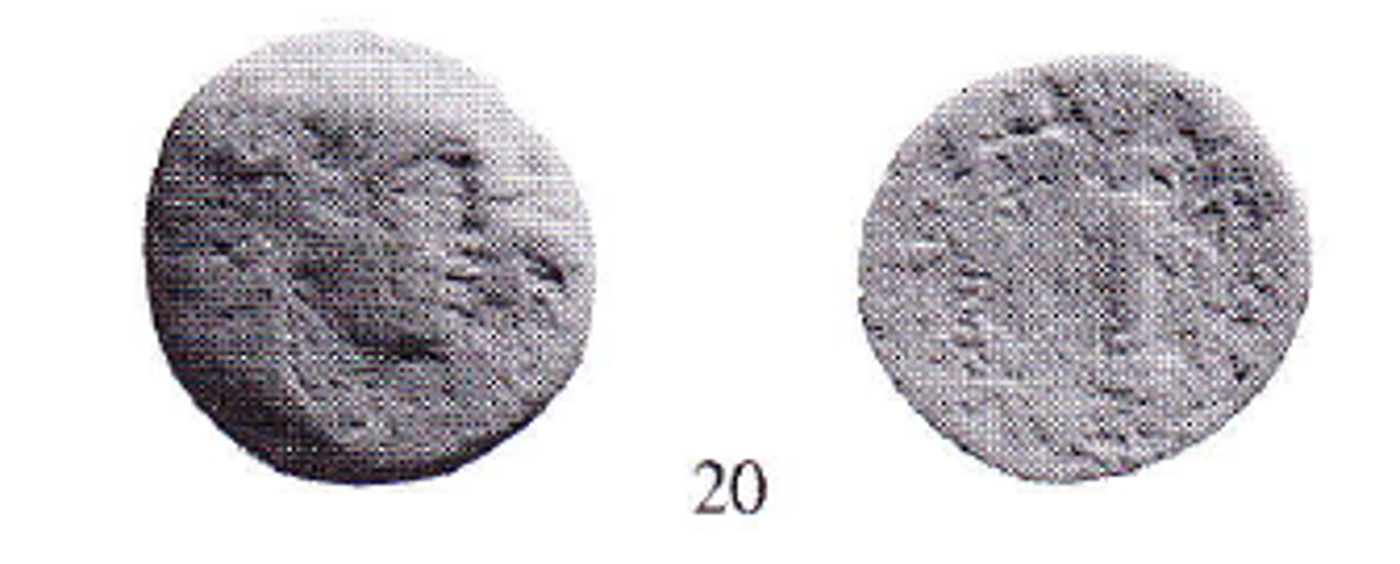3820 - Lysimachia (AE Heracles/Nike) over Antiochus II (Apollo/tripod) (Okray coll. - Arslan 1998, 20): Difference between revisions
From SILVER
m (Callatay moved page SO 347 - Lysimachia over Lysimachia to 347 - Lysimachia (AE Heracles/Nike) over Antiochus II (Arslan 1998, 20)) |
No edit summary |
||
| Line 1: | Line 1: | ||
{{Overstrike | {{Overstrike | ||
|Image overstriking coin=SO 347 - Lysimachia over Lysimachia.png | |Image overstriking coin=SO 347 - Lysimachia over Lysimachia.png | ||
| | |Image overstruck variety=Antiochus II Sardis tripod.jpg | ||
|Image reference overstruck variety=https://pro.coinarchives.com/a/lotviewer.php?LotID=2197483&AucID=5285&Lot=99 | |||
|Sale=CH 9, 188: Thrace, 1997, inv. n° 386 (appeared on market in Istanbul, purchased by a dealer from Ankara, then purchased by the collector Cafer S. Okray). | |||
|Private collection=Cafer S. Okray coll. | |||
|Obverse description=Head of Herakles right, wearing lion skin headdress. | |Obverse description=Head of Herakles right, wearing lion skin headdress. | ||
|Reverse legend=ΛΥΣΙΜΑΧΕΩΝ | |Reverse legend=ΛΥΣΙΜΑΧΕΩΝ | ||
| Line 8: | Line 11: | ||
|Mint=Lysimachia | |Mint=Lysimachia | ||
|Ancient region=Thrace | |Ancient region=Thrace | ||
|Date from= | |Date from=250 BCE | ||
|Date to=220 BCE | |Date to=220 BCE | ||
|Period=Hellenistic | |Period=Hellenistic | ||
| Line 16: | Line 19: | ||
|Axis=12 | |Axis=12 | ||
|Coin reference=Arslan 1998, p. 77-82, n° 20. | |Coin reference=Arslan 1998, p. 77-82, n° 20. | ||
|Coin series reference= | |Coin series reference=Arslan 1998, p. 77-82, n° 20.; HGC 3.2, n° 1500 | ||
|Overstruck obverse description= | |Overstruck obverse description=Head of Apollo right, wearing laurel wreath | ||
|Overstruck reverse legend= | |Overstruck reverse legend=BAΣΙΛΕΩΣ ANTIOXOY | ||
|Overstruck reverse legend language=Greek | |Overstruck reverse legend language=Greek | ||
|Overstruck reverse description= | |Overstruck reverse description=Tripod above anchor | ||
|Overstruck mint= | |Overstruck mint=Sardis | ||
|Overstruck ancient region= | |Overstruck ancient region=Lydia | ||
|Overstruck authority=Seleucid Dynasty (312-63 BC); Antiochus II Theos (Seleucid king, 261-246 BC) | |||
|Overstruck date from=261 BCE | |||
|Overstruck date to=246 BCE | |||
|Overstruck period=Hellenistic | |||
|Coin series reference overstruck=SC I, n° 525 | |||
|Coin series web reference overstruck=https://numismatics.org/sco/id/sc.1.525?lang=en | |||
|Frequency of overstrikes=frequent | |||
|Level of confidence=strong | |||
}} | }} | ||
Revision as of 08:06, 10 June 2023
250 BCE - 220 BCE | ΛΥΣΙΜΑΧΕΩΝ
Images
Overstruck variety

Antiochus II Sardis tripod.jpg [1]
Location/history
| Sale(s)Sale(s) ᵖ: | CH 9, 188: Thrace, 1997, inv. n° 386 (appeared on market in Istanbul, purchased by a dealer from Ankara, then purchased by the collector Cafer S. Okray). | |
| Private collection(s)Private collection(s) ᵖ: | Cafer S. Okray coll. |
Overstriking coin
Description
| ObverseInscription or printing placed on the obverse.: | Head of Herakles right, wearing lion skin headdress. | ReverseInscription or printing placed on the reverse.: | ΛΥΣΙΜΑΧΕΩΝ (Greek) Nike left holding wreath and palm. |
Mint and issuing power
| MintIdentifies the place of manufacture or issue of a numismatic object.: | Lysimachia | Ancient regionAncient region. | Thrace | Modern countryModern country: Turkey | AuthorityIdentifies the issuing power. The authority can be "pretended" when the name or the portrait of X is on the coin but he/she was not the issuing power. It can also be "uncertain" when there is no mention of X on the coin but he/she was the issuing power according to the historical sources: |
Chronology
| FromIdentifies the initial date in a range assigned in a numismatic context. 250 BCE toIdentifies the final date in a range assigned in a numismatic context.. 220 BCE | Hellenistic 323-30 BC |
Physical description
| MetalThe physical material (usually metal) from which an object is made.: Bronze |
WeightWeight of the numismatic object (in grams). in grams: 3.523.52 g <br />3,520 mg <br /> | AxisDescribes the directional relationship between the obverse and reverse of a numismatic object.: 1212 mm <br />1.2 cm <br /> | |
| DiameterDescribes diameter of an object (in mm).: 1818 mm <br />1.8 cm <br /> | |||
References
| Coin referenceReference of the Coin: | Arslan 1998, p. 77-82, n° 20. | Coin series referenceReference to coin series study: | Arslan 19981Arslan 1998, p. 77-82, n° 20., HGC 3.22HGC 3.2, n° 1500 |
Overstruck type
Description
| ObverseInscription or printing placed on the obverse.: | Head of Apollo right, wearing laurel wreath | ReverseInscription or printing placed on the reverse.: | BAΣΙΛΕΩΣ ANTIOXOY (Greek) Tripod above anchor |
Mint and issuing power
| MintIdentifies the place of manufacture or issue of a numismatic object. ᵖ: | Sardis | Ancient regionAncient region. ᵖ | Lydia | Modern countryModern country: Turkey | AuthorityIdentifies the authority in whose name (explicitly or implicitly) a numismatic object was issued. ᵖ: | Seleucid Dynasty (312-63 BC), Antiochus II Theos (Seleucid king, 261-246 BC) |
Chronology
| FromIdentifies the initial date in a range assigned in a numismatic context. 261 BCE toIdentifies the final date in a range assigned in a numismatic context.. 246 BCE | Hellenistic 323-30 BC |
Physical description
References
| Coin type referenceReference to coin series study ᵖ: | SC I3SC I, n° 525 | ||
| Coin series web reference overstruckCoin series web references overstruck: | |||
Additional data
| Frequency of overstrikesFrequency of overstrikes: | frequent | Level of confidenceLevel of confidence of the identification: | strong |
| RemarksRemarks: | |||
References
- ^ Arslan, Melih (1998), "A hoard of bronze coins of Lysimachia", in Ulrike Peter (ed.), Stephanos nomismatikos : Edith Schönert-Geiss zum 65. Geburtstag, Berlin, p. 77-82.
- ^ Hoover, Oliver D. (2017), Handbook of Coins of Macedon and Its Neighbors. 3. Part 2: Thrace, Skythia, and Taurike, Sixth to First Centuries BC, Lancaster-London, xix, 232 p.
- ^ Houghton, Arthur - Lorber, Catharine (2002), Seleucid coins : a comprehensive catalogue. Part 1, Seleucus I through Antiochus III, New York - Lancaster - London, 2 v. (xxxviii, 488 p. + 300 p.), 101 pl.
